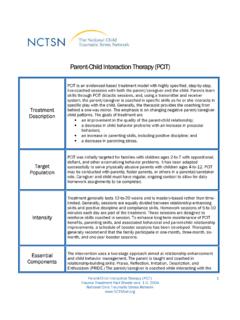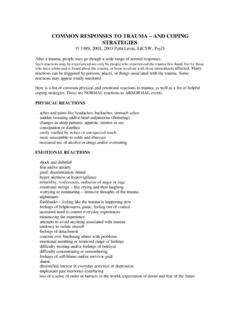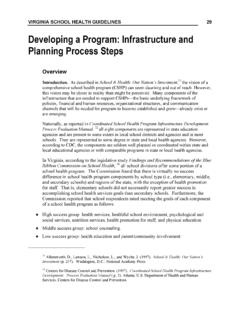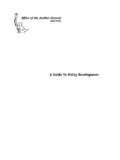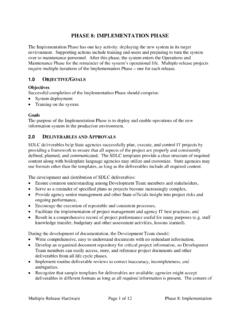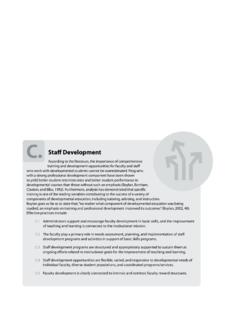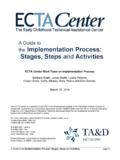Transcription of Development and Implementation of Trauma-Informed ...
1 123 Journal of Family Violence ISSN 0885-7482 J Fam ViolDOI and Implementation ofTrauma-Informed Programming in YouthResidential Treatment Centers Using theARC FrameworkHilary B. Hodgdon, KristineKinniburgh, Dawna Gabowitz, MargaretE. Blaustein & Joseph Spinazzola123 Your article is protected by copyright and allrights are held exclusively by Springer Science+Business Media New York. This e-offprint isfor personal use only and shall not be self-archived in electronic repositories. If you wishto self-archive your article, please use theaccepted manuscript version for posting onyour own website. You may further depositthe accepted manuscript version in anyrepository, provided it is only made publiclyavailable 12 months after official publicationor later and provided acknowledgement isgiven to the original source of publicationand a link is inserted to the published articleon Springer's website. The link must beaccompanied by the following text: "The finalpublication is available at.
2 TREATMENT MODELS FOR TRAUMATIZED YOUTH IN RESIDENTIAL TREATMENT SETTINGS: EMERGING EVIDENCE BASED evelopment and Implementation of Trauma-InformedProgramming in Youth Residential Treatment CentersUsing the ARC FrameworkHilary B. Hodgdon&Kristine Kinniburgh&Dawna Gabowitz&Margaret E. Blaustein&Joseph Spinazzola#Springer Science+Business Media New York 2013 AbstractThis project describes application of an evidenced-based, Trauma-Informed treatment framework, Attachment,Regulation and Competency (ARC), with complexly trauma-tized youth in residential treatment. The processes ofimplementing the ARC model into clinical and milieu pro-gramming at two residential treatment programs are de-scribed. Particular attention is paid to system-level processesand strategies for embedding ARC in a sustainable data demonstrated a significant relation between use ofARC and reductions in PTSD symptoms, externalizing andinternalizing behaviors, and the frequency of restraints usedacross programs.
3 Preliminary findings contribute to an emerg-ing empirical basis for the ARC model and are supportive ofits clinical utility as a practice in the residential context. Nextsteps include: a) expanding the study findings by conductingcontrolled efficacy research, b) examining system level vari-ables as mediators of change, and c) describing the full oper-ation stage of Implementation of the ARC year in the United States, millions of children experiencemaltreatment, violence and severe neglect, the majority ofwhich occurs within the family environment. In the mostrecent National Incidence Study of Child Abuse and Neglect(NIS-4; Sedlak et ), biological parents were identifiedas the perpetrators of 81 % of substantiated cases of childmaltreatment in the United States, with nonbiological parentsand their partners, and other family members, accounting foran additional 12 % and 4 % of cases. Despite the proliferationof state and federal family preservation initiatives over the pasttwo decades, it remains an unquestionable fact that family continues to be a construct fraught with peril and home adangerous place for far too many American children.
4 With thisreality in view, it is hardly surprising that in the latest annualincidence report compiled by the federal Children sBureau,nearly 134,000 child victims of maltreatment were doc-umented to have been removed from their families and placedin substitute care ( Department of Health and HumanServices2012).One form of substitute care, residential treatment, is con-sidered by some to be the end of the road for youth whohave failed out of less restrictive environments such asfoster homes, group homes, or kinship care (Rivard et ). Residential treatment can provide a level of structure,security and predictability unavailable in other settings whileallowing youth to continue to attend school and receive ther-apeutic services. However, because of the high cost andcomparatively restrictive nature of residential treatment, arelatively severe psychological and behavioral presentationis increasingly required for youth to qualify for this level ofcare (Briggs et ,b).
5 The chronic and complex symptom presentation observedamong youth in residential placement can often be linkeddirectly to a history of abuse and neglect, exposure to violencein the community, and multiple placement transitions andattachment disruptions (Doyle and Bauer1989;ZelechoskiH. B. Hodgdon (*):K. Kinniburgh:D. Gabowitz:M. E. Blaustein:J. SpinazzolaThe Trauma Center at Justice Resource Institute, 1269 Beacon Street,Brookline, MA 02446, USAe-mail: 's personal copyet ). Research examining rates of self-reported historyof childhood trauma among youth in secure settings yieldsrates varying from 26 to 92% (Briggs et ,b; Lewisand Shanok1979), with rates varying depending on how trauma is defined. According to Briggs et al. (2012a,b),youth in residential placement, when compared to youth re-ceiving other types of care, have a greater number of traumaexposures (M= exposures vs. M= exposures, respec-tively) and are more likely to report experiencing multipletraumatic events (92 % of youth in residential vs.)
6 77 % ofyouth not in residential), contributing to a cumulative or dose response relationship of trauma to placement transitions are also a common experience,with one study finding an average of six previous out of homeplacements and three inpatient hospitalizations among youthin residential care (Rivard et ).Not only do youth in residential placement have highlycomplex trauma histories and many placement disruptionsand transitions, they also display greater functional impair-ment when compared to youth receiving services in non-residential settings. A recent study by Briggs and colleagues(2012a,b) compared rates of functional impairment among anational sample of children and adolescents receiving mentalhealth services from providers who are part of the NationalChild Traumatic Stress Network (NCTSN). The study find-ings indicated that youth in residential placement had higherrates of impairment across a range of domains includingacademic problems, behavior problems, attachment problems,runaway behavior, substance abuse, suicidal ideation, self-injury, and criminal behavior.
7 In addition, whereas bothgroups demonstrated significant improvements after receivingtreatment, a third of youth in residential placement continuedto display difficulties in one or more is clear that trauma is a core issue for many youth enteringresidential treatment, and is likely a major contributor to theiremotional disturbance including trauma-related mental healthproblems (Zelechoski et ; Knoverek et ).Indeed, in a survey conducted of a national sample of residentialtreatment centers, 84 % indicated that posttraumatic stress disor-der (PTSD) was one of the primary psychological disorderspresent among youth upon admission (National Association ofPsychiatric Health Systems2011). However, youth in residentialplacement rarely have access to Trauma-Informed treatment. Thisis despite recognition in the field for several decades that trauma-sensitive services are beneficial and necessary for youth inresidential placement (see Doyle and Bauer (1989) for an earlyexample of trauma informed programming in residentialplacement).
8 Why the gap in trauma informed residential care when theyouth served in such settings would benefit greatly from suchan approach? Recent research has demonstrated successfulimplementation of Trauma-Informed programming in residentialsettings with complex youth (Ford and Hawke2012).However, there are two interrelated barriers to implementingsuch a practice. First, most current available trauma treatmentshave been developed for the individual or group therapy con-text. Residential treatment, by nature, is ongoing 24 hours aday, 7 days a week, 365 days a year and cuts across all contextsthrough which youth move ( , school, milieu, social, andclinical), and therefore a circumscribed trauma treatment ( ,one that is delivered only via individual or group therapysessions) is less likely to be effective. Additionally, the mostcommonly used trauma treatment for youth, Trauma FocusedCognitive Behavioral Therapy (TF-CBT), is contraindicated foryouth who have: (a) current self-harm or suicidal behaviors (acommon problem for many youth in residential care), (b) lack afamily system that can provide empathic support during traumaprocessing (youth in residential care often have unstable familyconnections, if any at all), and/or (c) are at risk for furthertrauma exposure (youth in residential care are at increased riskfor revictimization due to higherrates of run-away behaviors).
9 A second barrier is that, given limited resources and highneed to establish safety, most residential treatment facilitiesprioritize training for line staff in management of problembehaviors over Trauma-Informed practices. Risky behaviorssuch as self-harm, suicidal, and run-away that contribute to theyouth s placement and often continue beyond admission arenecessarily a focus of intervention. However, the very behav-ior management techniques and safety procedures that aredesigned to reduce unsafe behavior ( , use of restraint) aretriggering for traumatized youth, leading to increaseddysregulation and reactivity. This paradox points to a needto integrate Trauma-Informed approaches in the milieu that gobeyond individual or group therapy because milieu staff areoften on the front lines in helping youth to manage the highlevels of dysregulation that lead to reactive aggression, self-harm and run-away of trauma-impactedyouth in residential settingsrequires an overarching Trauma-Informed treatment approach orframework that is accessible enough to be taught to a variety ofstaff ( , administrators, clinicians, and residential counselors)and flexible enough to be applied across contexts ( , school,therapeutic, and milieu).
10 Creating a Trauma-Informed therapeu-tic milieu that extends beyond the individual therapy hour iscritical for traumatized youth who require ongoing support intheir day to day interactions with the ProjectThe approach utilized to develop Trauma-Informed program-ming at the residential settings described in this paper is basedon the Attachment, Self-regulation and Competency (ARC)framework (Blaustein and Kinniburgh2010; ), an evidence based practice (EBP) recognized by theSubstance Abuse and Mental Health Services 's personal copyThe Development of the ARC framework was informed byboth the available research evidence and clinical expertise indefining the core components of child complex trauma inter-vention, thereby qualifying it as an EBP as defined by theAPA task force on evidenced based practice (Levant2005).Complex trauma exposure has been linked to disruptionsacross multiple domains of Development spanning attach-ment, biological processes, self-regulatory capacity, cognitionand self-concept (Cook et ; ;vander Kolk2005).
